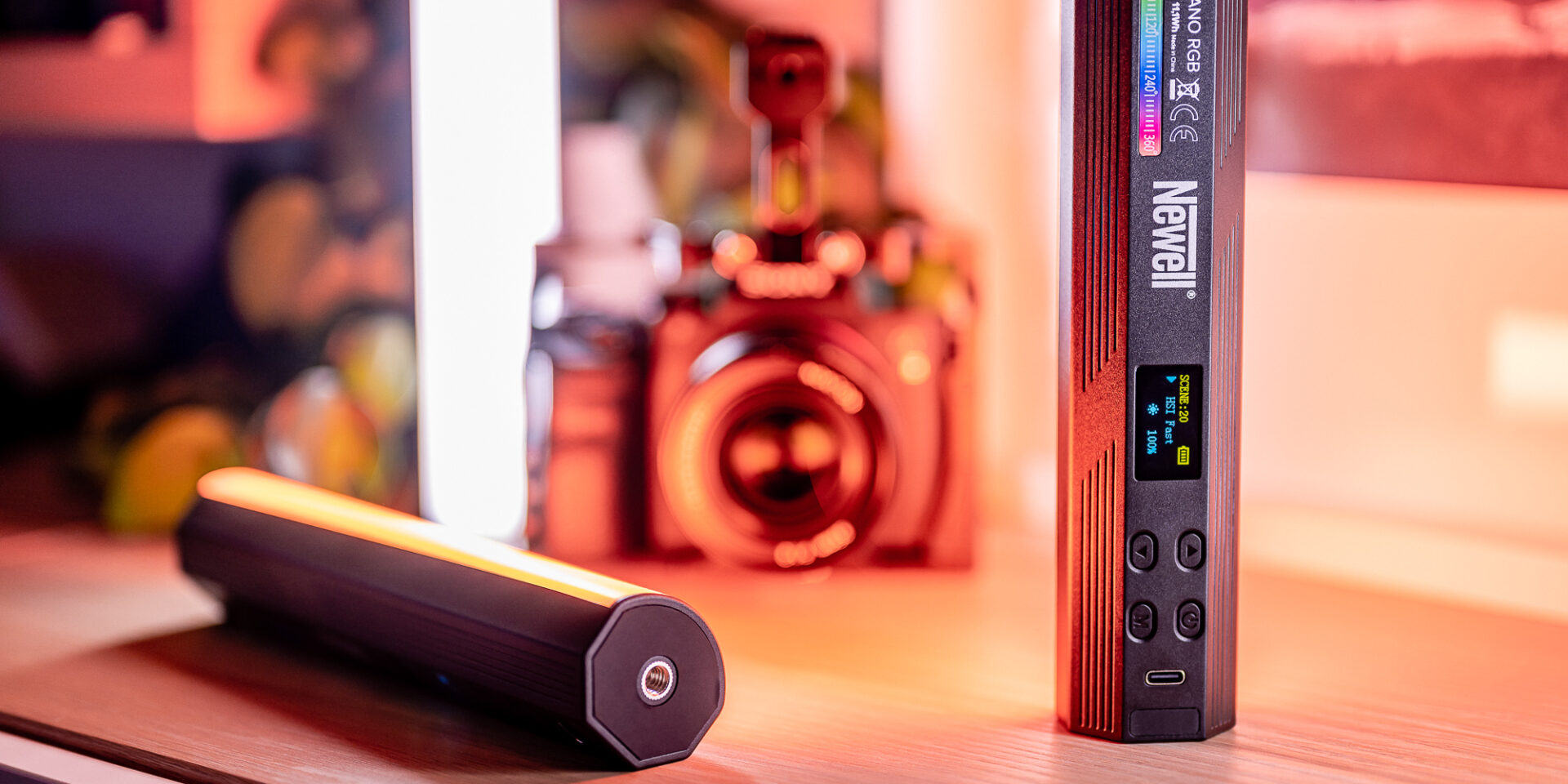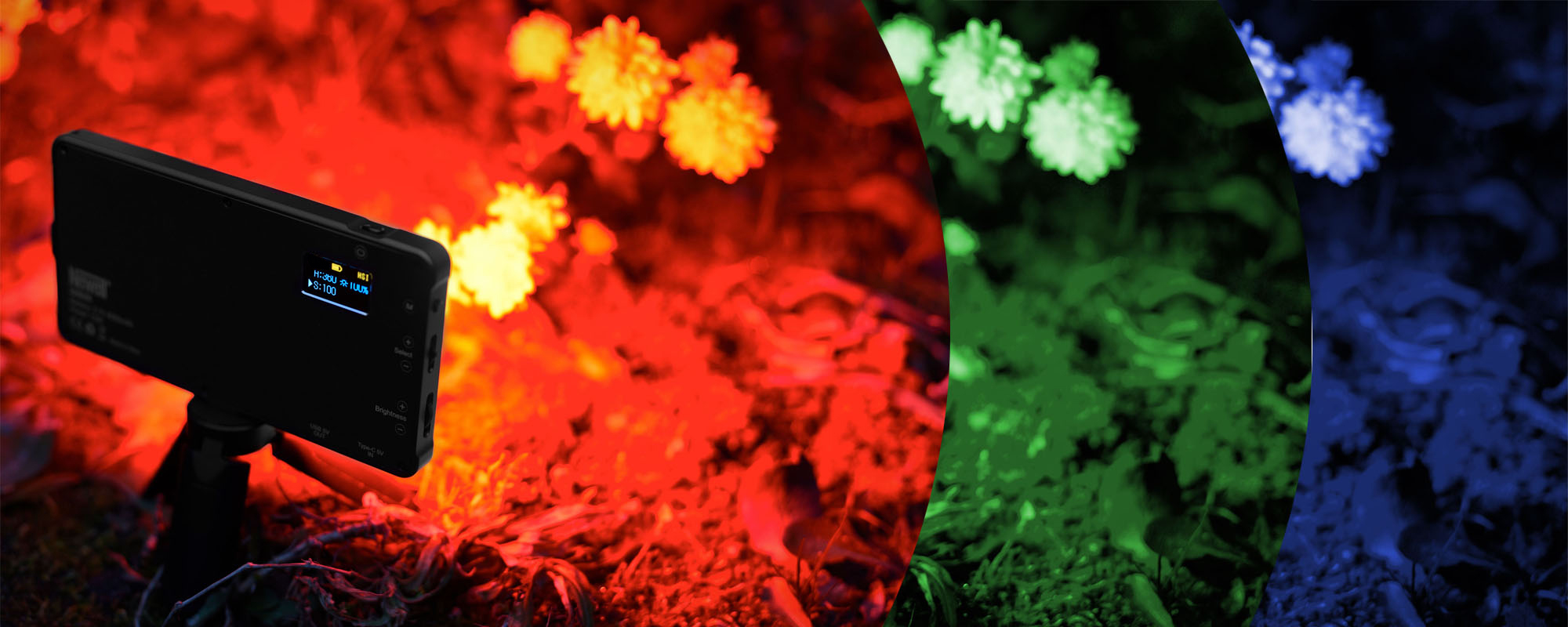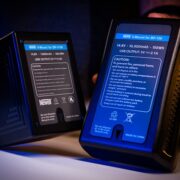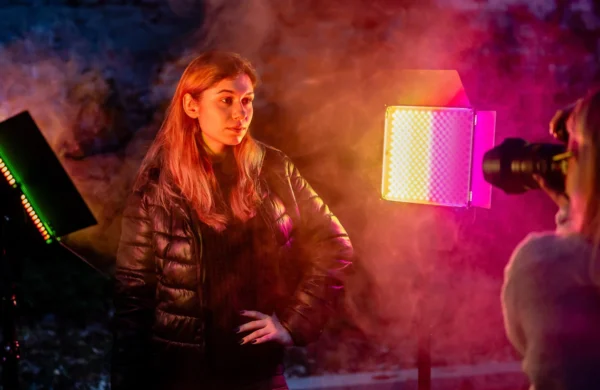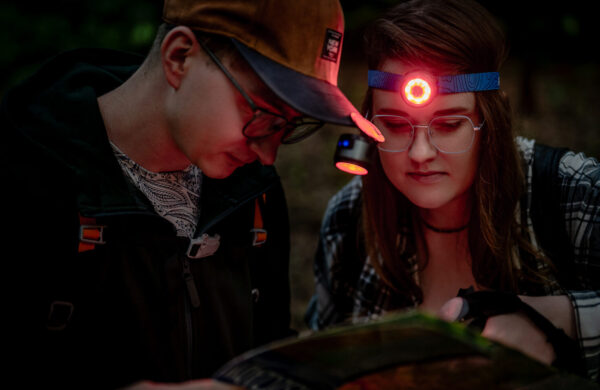One of the key elements that affect the quality and atmosphere of videos and photos is lighting. In the last decade, LED lights have become particularly popular. They are affordable, energy-efficient, offer great light quality, and most importantly, this product segment is no longer reserved only for professionals. When starting your adventure with LED lighting, whether for vlogging or photo shoots, it’s a good idea to familiarize yourself with the basic terms and principles of studio lamps. And that’s why today we’re taking on the color temperature of light (CCT) – a variable parameter that will help you effectively create the atmosphere of your frames.
In this article, we will explain such issues as:
- color temperature of light (CCT),
- what is the Ra scale,
- color rendering index (CRI),
and we will also answer questions such as:
- what role color temperature plays in the world of film and photography,
- which Newell LED lamps offer variable color temperatures.
How does the color of light create a mood?
Many of us, when watching a film or photos, have certainly noticed differences in the colors and atmosphere of the images presented. Have you ever wondered why a night scene in a movie can appear warm and cozy, while photos of a daytime landscape can exude cold and chilly tones? The secret to these treatments is properly chosen color temperature, a key factor affecting the perception of colors and the mood of a visual story.
But color temperature is only one of the elements that affect the mood in a film. For the treatment to be successful, we need good quality light. With the development of new technologies, filmmakers have gained the ability to choose light sources with a high color rendering index (CRI), which serves us colors in a more natural way and with a more faithful rendering of reality. The Ra scale, on the other hand, provides more precise information about the quality of lighting. All of these elements are extremely important in the film and photographic production process, affecting not only the final appearance of the image but also the perception of emotions that are transmitted to the viewer.
In the remainder of this article, we will focus on elaborating on these issues and provide practical tips on how to effectively use LED lights from Newell to achieve the desired color temperature in various film and photography scenes.
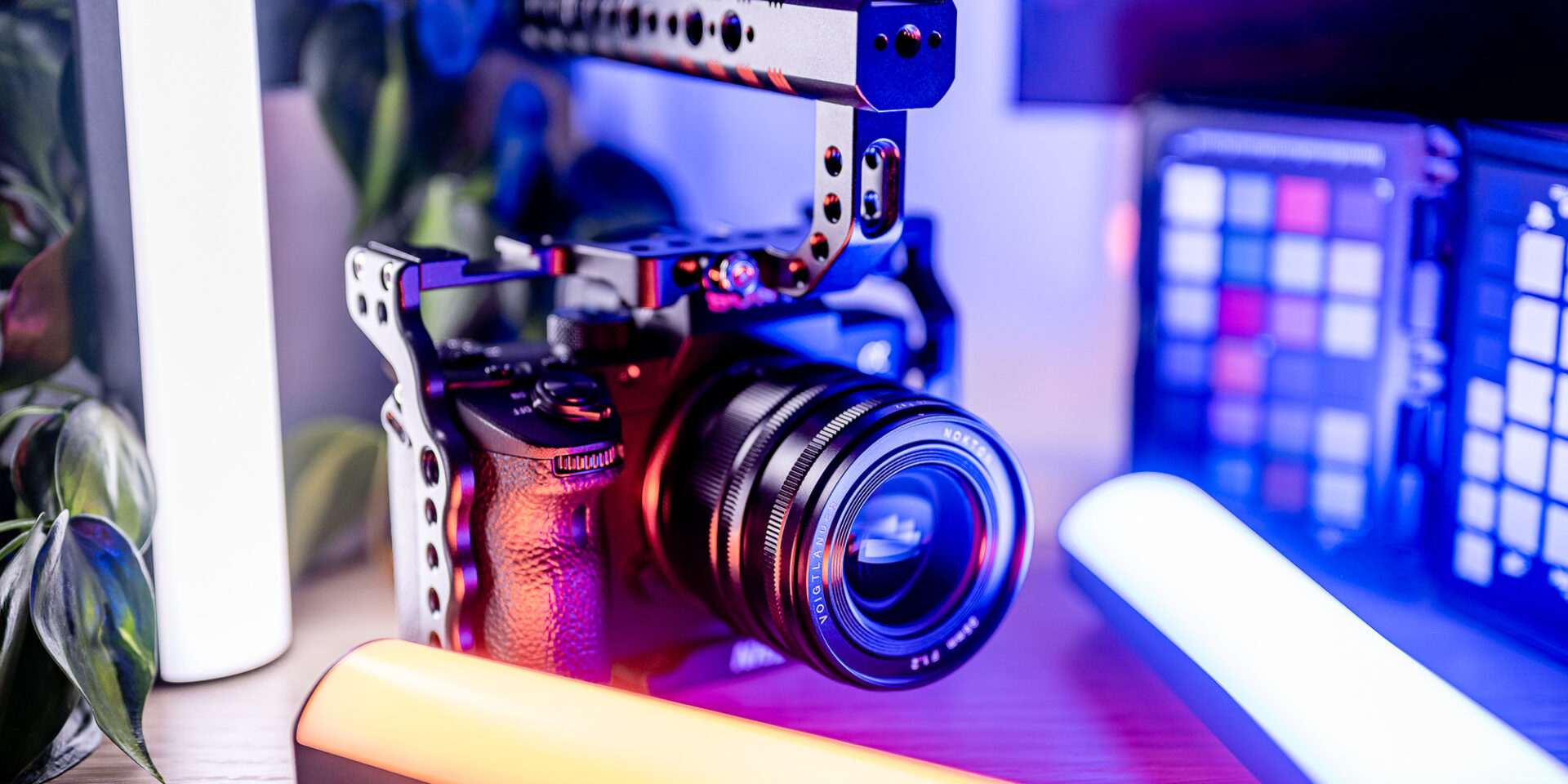
What is the color temperature of light?
Color temperature is a fundamental concept in lighting, film, and photography. It is a key element affecting the appearance, mood, and color perception in images. The term refers to the color emitted by a light source, not its actual physical temperature. It is expressed in kelvins (K) and reflects the characteristic shade of light a source emits. Low values, such as 2700K, correspond to warm shades, while higher values, such as 7000K, are associated with cold shades.
Kelvins (K) – the unit of color temperature of light
The Kelvin scale allows us to classify light sources according to their color temperature. At one end of the scale, we have warm light (such as candles or incandescent bulbs), and at the other end cold light (such as daylight on a cloudy day). With this scale, creators can control exactly what atmosphere they want to achieve in their designs.

Effect of color temperature on visual perception
Color temperature has a huge impact on the viewer’s perception. For example, warm light can create a cozy and romantic atmosphere, ideal for love or nostalgic scenes. On the other hand, cold light can add dynamism and harshness, which suits action or sci-fi scenes.
In Newell’s product line, you’ll find a number of lamps that offer variable light color temperatures – from 2500 K, all the way up to 9900 K. Here’s what the different CCT values are:
- 2000K: A very warm, yellowish light. Similar to the light of a setting sun. Perfect for creating a romantic, nostalgic atmosphere in night scenes or indoors where you want to evoke a warm feeling.
- 3000K: Warm, yellowish light, similar to classic incandescent light. Ideal for creating cozy and intimate interiors, especially in domestic scenes or interpersonal relationships.
- 4000K: Neutral, natural light, similar to the light that accompanies, for example, a full moon. Creates a realistic and neutral opening, great for portraits and outdoor scenes.
- 5000K: Bright, cold light resembling natural sunlight on a cloudless day. Works well in scenes full of energy and dynamism, such as action movies or sports photography.
- 6000K: Colder light, ideal for highlighting contrasts. Useful in scenes where you want to emphasize details or create a cool, modern aura.
- 7000K and more: A very cold, bluish light. Can be used for artistic purposes to create an unusual atmosphere or to introduce a certain distancing aesthetic.
Different color temperatures allow artists to experiment with moods and evoke certain emotions. The right LED light can change the perception of a scene, adding depth and character, making them indispensable tools in filmmaking and photography.
The effect of color temperature on mood and emotion
In the previous chapter, we learned that color temperature is crucial to color perception in images. However, its influence goes far beyond that. Now we will dive into the world of emotions and moods that can be evoked by adjusting the color temperature accordingly.
Every film and photo tells a story, and properly chosen lighting can enhance the message or, on the contrary, disrupt the creator’s intentions. The right color temperature is a key element in creating the mood and atmosphere of a scene.
- Warm light – coziness and intimacy: Warm shades of light, such as those at 2700K-3500K, are often associated with comfort and tranquility. Scenes set in warm, soft light can emphasize emotions, especially in terms of relationships between characters.
- Cold light – tension and drama: Cold light tones (5000K and above) can add tension and drama to scenes. Combined with the right frame composition, they can create a feeling of unease or mystery, which is ideal in action scenes or thrillers…
- Neutral light – a faithful representation of reality: Neutral light (4000K-4500K) is the closest to natural daylight. For this reason, it is often used in portrait photography and documentaries, where color fidelity and naturalness are key.
Color psychology is the science of how colors affect the human psyche. Color temperature is one of the key aspects of color psychology. For example, warm colors like red can evoke emotions of passion or anger, while cool colors like blue can be associated with calm and melancholy.
CRI (Ra), or color rendering index
The color rendering index, also known as CRI, is an important parameter that determines the ability of a light source to accurately render colors compared to a reference light. The CRI value is measured on a scale from 0 to 100, where 100 indicates the highest quality of color rendering. Newell’s LED lamps are equipped with technology that guarantees high CRI values, which translates into realistic and reliable color rendering.
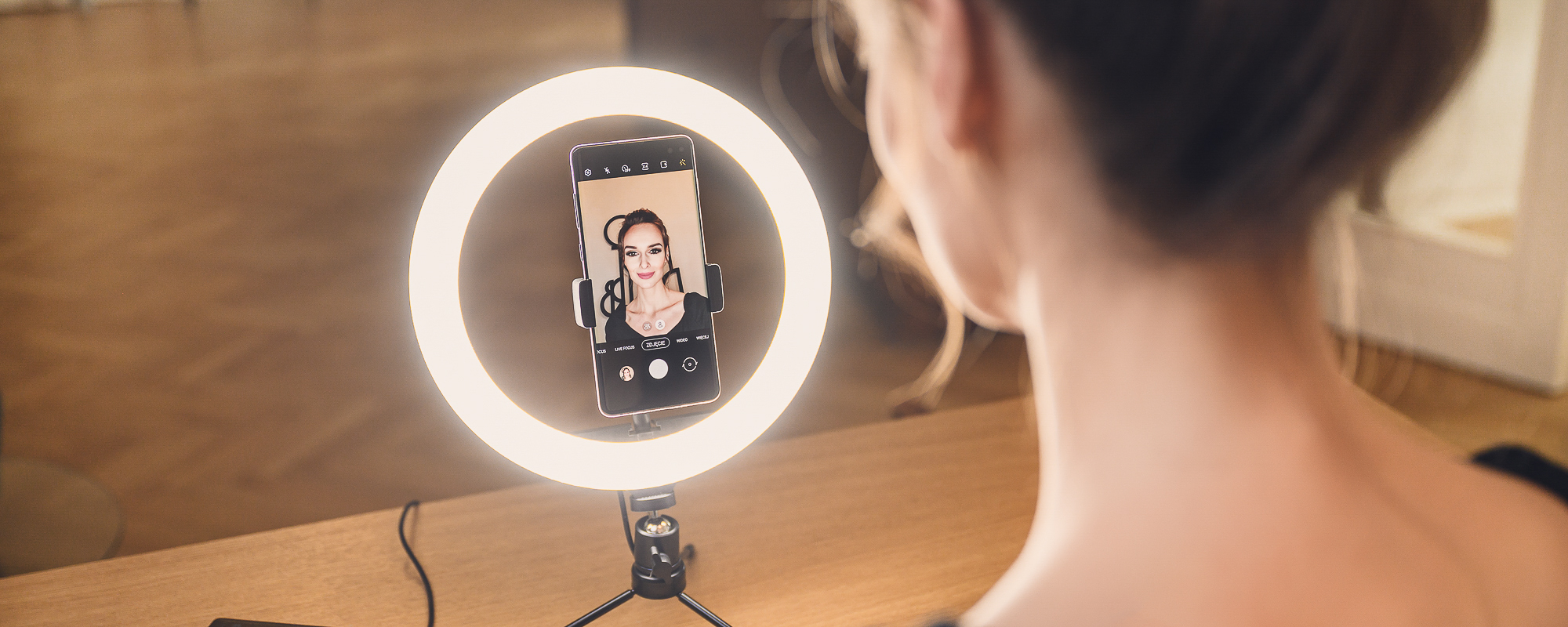
CRI VS. Ra, how do they differ?
CRI (color rendering index) can be defined as a quantitative measure of a light source’s ability to faithfully show different hues compared to a natural light source. The CRI value is expressed as a percentage, and the closer the CRI of a light source is to 100%, the better the quality of color rendering. But on the Internet, you can also find the Ra coefficient, which often appears as a synonym for CRI. Are they the same thing? Both yes and no. In a nutshell, the difference between CRI and Ra is that in the Ra index, the measurement is based on 8 standardized colors, while with CRI the measurement includes 6 more colors. CRI has 15 colors, designated as:
- R1, reddish gray;
- R2, dark yellowish gray;
- R3, saturated yellow;
- R4, moderate yellowish green;
- R5, pale turquoise;
- R6, light blue;
- R7, purplish blue;
- R8, light pink purple;
- R9, saturated red;
- R10, saturated yellow;
- R11, saturated green;
- R12, saturated blue;
- R13, white skin color;
- R14, leaf green;
- R15, yellow skin color.
Meanwhile, Ra is the average value of the color rendering index for the first eight colors, presenting the ability of a light source to render colors.
Importance of high CRI
Lamps with a high CRI are irreplaceable in the field of film and photography. They ensure that colors are presented with optimal fidelity and naturalness, which affects the viewer’s authentic perception of the image. This is especially crucial in areas where color accuracy is crucial, such as in fashion photography or commercial film production.
Low CRI
Lamps with low CRI/RA can lead to color distortion. In extreme cases, the appearance of skin can appear unhealthy, and products can lose their attractive appearance. That’s why it’s worth investing in high-quality light sources, such as those we offer as part of the Rangha, Air or Kathi series, among others, which provide high color rendering indexes.
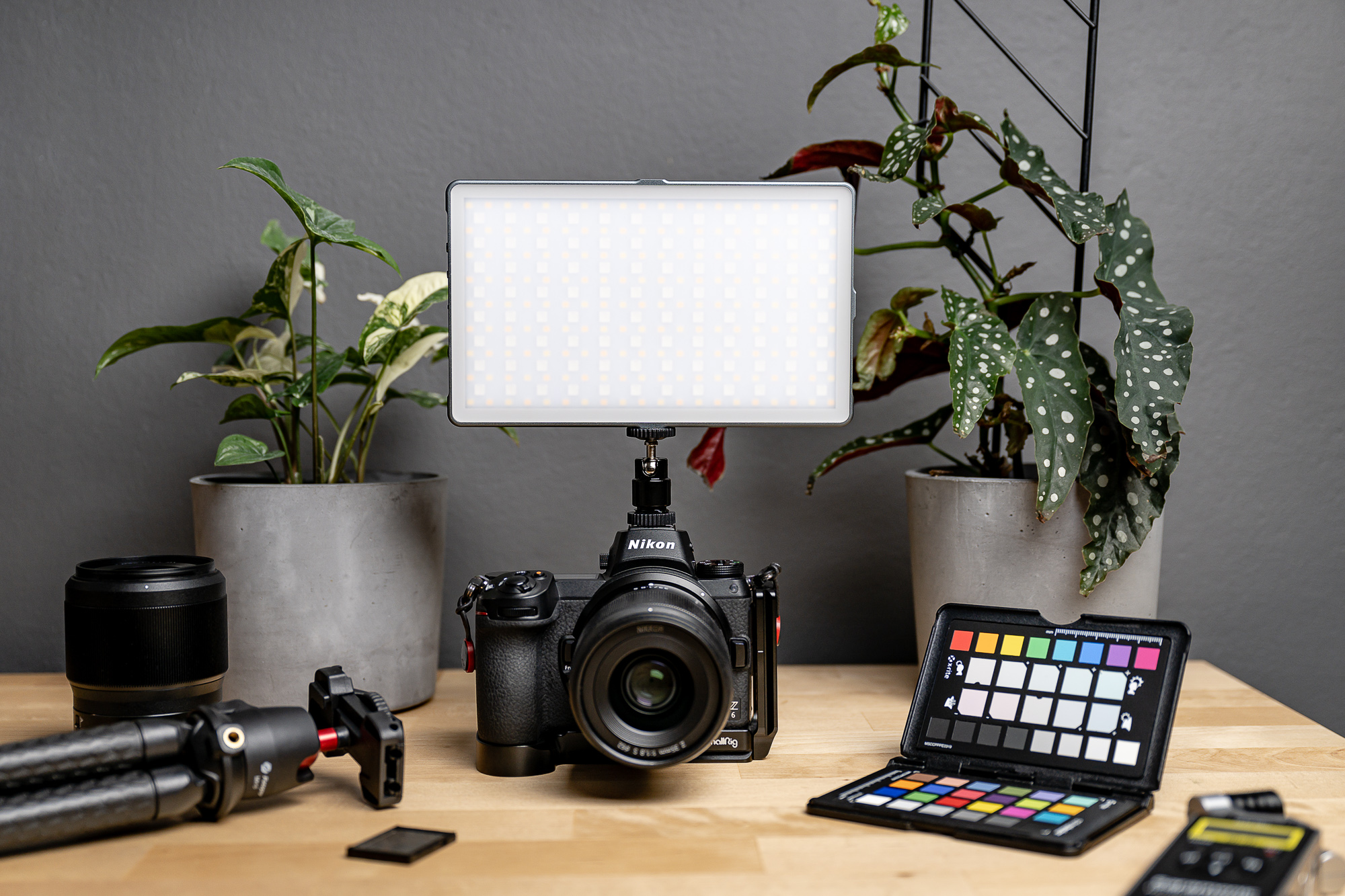
Choosing the right LED lamps
You already know that color temperature and CRI ratings are key factors affecting the quality of light emitted by LED lamps. It’s time to move on to practice. How do you choose the right LED lamps to get the desired results in filmmaking and photography? We will try to answer this question.
Parameters of LED Lamps (color temperature and CRI)
The basic step in choosing the right LED lamps is to understand and consider 2 key parameters: color temperature and CRI. These parameters determine how the lamps will render colors and the mood of the scenes. The choice of color temperature depends on the characteristics of the environment. For cozy interiors, warm light is worth considering, while for dynamic outdoor scenes, cold light will suit better. Well-chosen LED lamps with high CRI and RA allow colors to be rendered naturally and faithfully. This is important in terms of the emotions conveyed in scenes, both subtle and expressive.
While choosing the right LED lights is crucial, it’s also worth remembering that much can be improved in post-production. Color correction and color temperature adjustment possibilities are provided by graphic editing. The LED lamp market is constantly evolving, offering better quality and more efficient solutions. Technologies such as color temperature control and light intensity adjustment are opening up new possibilities for creatives. LED lamps are a tool that allows creators to precisely shape the atmosphere of frames, affecting the perception of emotions and mood. Choosing the right lamps is, despite appearances, an integral part of the creative process. Here are some suggestions for our lamps, which offer high CRI values and a wide range of light color temperature adjustments.
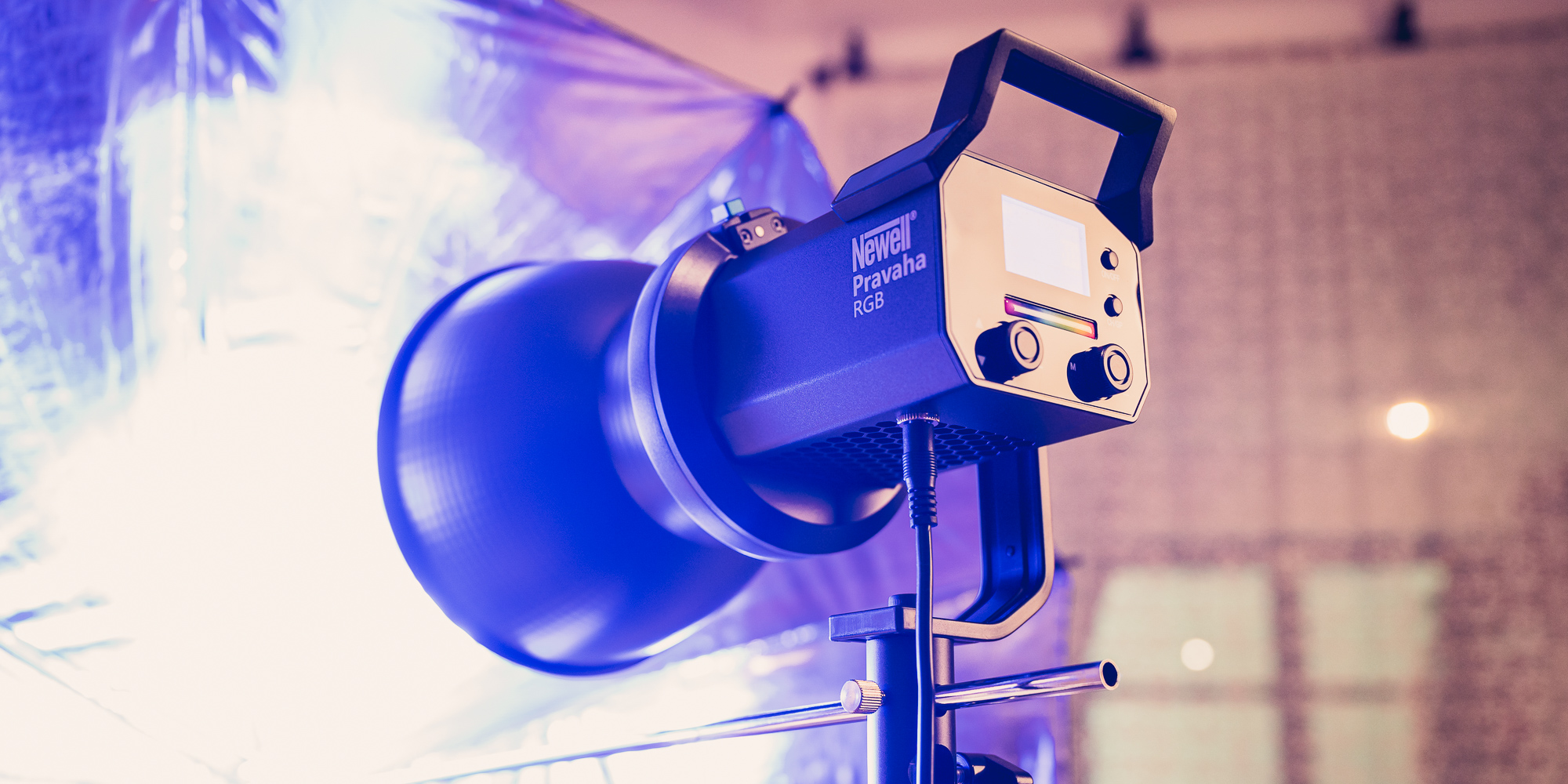
Newell RGB Pravaha LED
Those looking for powerful light output, an extensive range of color temperature adjustment (2800 – 10000 K), rich colors in HSI and RGBCW systems, and ready-made special effects will certainly like the RGB Pravaha model. All these features are enclosed in a compact housing with a cooling system, which will successfully perform both at home and in the studio. Ideal for commercial or outdoor projects. With the included diffuser, the final light output is increased, and the versatile Bowens mount allows the installation of a variety of modifiers. Control is possible both remotely and via an easy-to-read LCD display. A convenient carrying bag is also included.
Newell Air Artha XL RGB RC APP
The round panel with a built-in diffuser offers 70 watts of power, which translates into an impressive light output of up to 2,500 lumens. Adjustable color temperature from 2,500 to 8,500 K and HSI’s full-color palette give you tremendous flexibility to adapt the lighting to different situations. A free mobile app and remote control allow remote control of the unit at a distance of up to 15 meters. The ability to work with other lights is an added bonus. There are 49 special effects available. Two power modes – power supply or V-Mount battery – provide even more versatility.
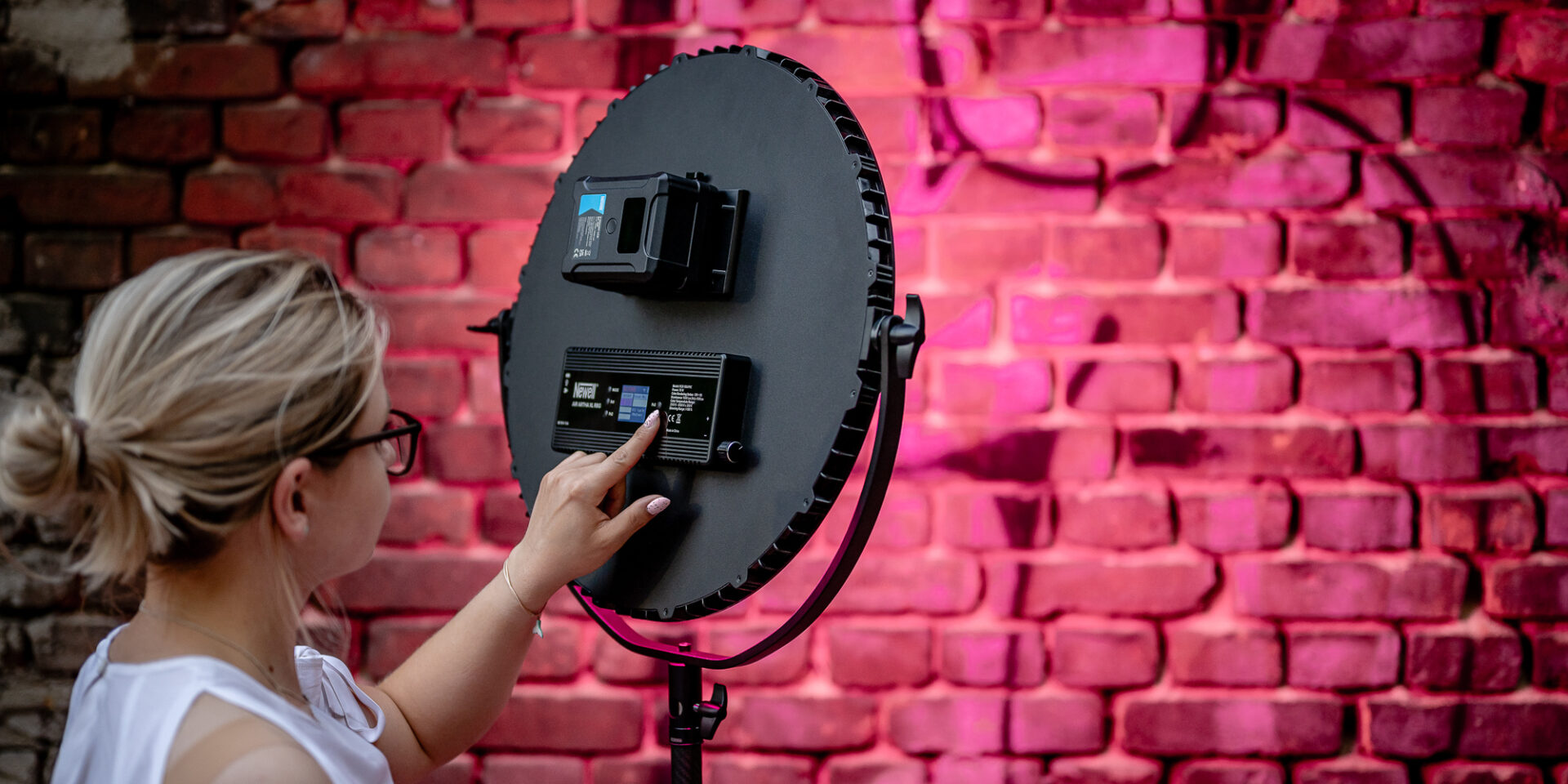
Newell RGB Kathi II
Kathi II is the next generation of Newell’s well-received lightsaber, which is sure to find dozens of applications in the world of film and photography. The lamp offers a large range of color temperature (from 2500 to 9000 K) and color (HSI) adjustments, allowing full control over the hue, saturation and intensity of the light. A 2600 mAh battery provides up to 70 minutes of operation at maximum brightness. Kathi II features 20 preset special effects. Intuitive buttons and a backlit screen make it easy to control parameters, and a USB-C port allows convenient charging with a power bank. The lamp can be easily attached to a tripod with a 1/4″ thread. The ergonomic design allows you to work comfortably in any position.

Newell RGB-W Rangha Max XL
Newell RGB-W Rangha Max XL is a compact LED panel with impressive dimensions of 28 by 18 cm, dedicated to both photographers and video makers. The device allows you to adjust the color temperature from 2500 to 9900 K, as well as manipulate colors in the HSI color space. Ergonomic knobs and buttons and an easy-to-read OLED screen ensure intuitive operation. Three 1/4″ threads and an included cold-shoe adapter allow the use of a variety of accessories. The built-in battery can be charged via a USB-C port, which also allows powering other devices. The lamp is enhanced with 21 special effects, including strobe, candle effect or police car roosters.
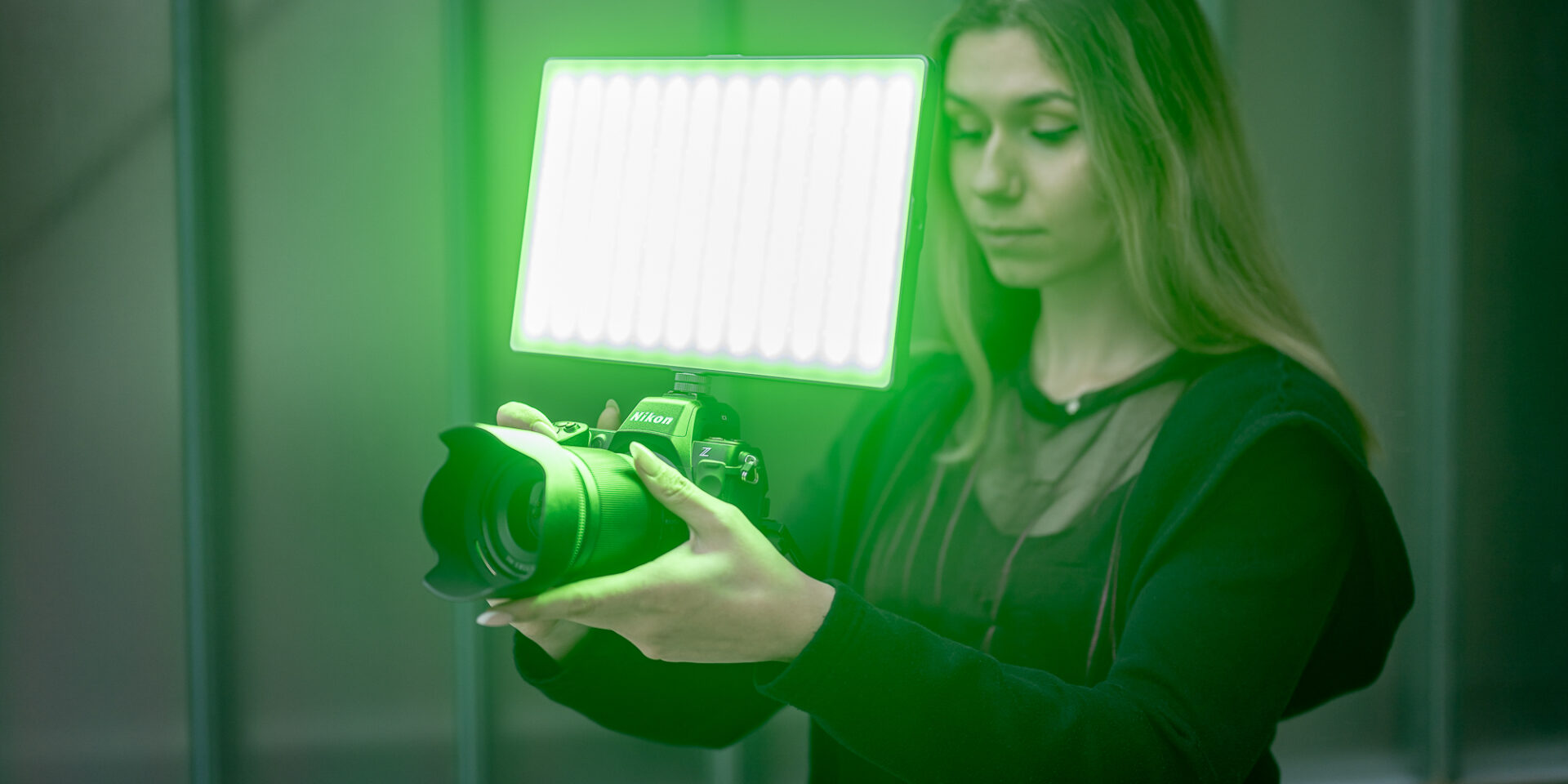
Newell Air 1100 RGB BD APP
The Newell Air 1100 RGB BD APP LED lamp is a versatile light source that measures 38.4 cm x 27.4 cm. It offers a maximum power of 50 watts and a light output of up to 1800 lumens, making it ideal for film and photography. The lamp has up to 360 colors of light, allowing full control over saturation and brightness. With adjustable color temperature, ranging from 2500 to 8500 K, you can adjust the lighting to suit changing conditions. The remote control and mobile app allow you to remotely control the lamp from up to 15 meters away. The unit can be powered traditionally with a power supply or two NP-F batteries. Metal gates and a diffuser provide controlled light dispersion.

LED Newell RL-18A – WB (3200 K – 5500 K) – Arctic White (Ring Light)
The Newell RL-18A LED ring light is a versatile tool ideal for portrait, product and macro photography. It’s an ideal choice for vloggers and creators posting on platforms such as Twitch, Instagram, TikTok and YouTube. The Newell RL-18A is great for supporting makeup and makeup work, thanks to its even lighting of the face. Adjustable power and color temperature allow you to fine-tune the lamp for different situations. The remote control, tripod and smartphone holder allow you to quickly change settings.
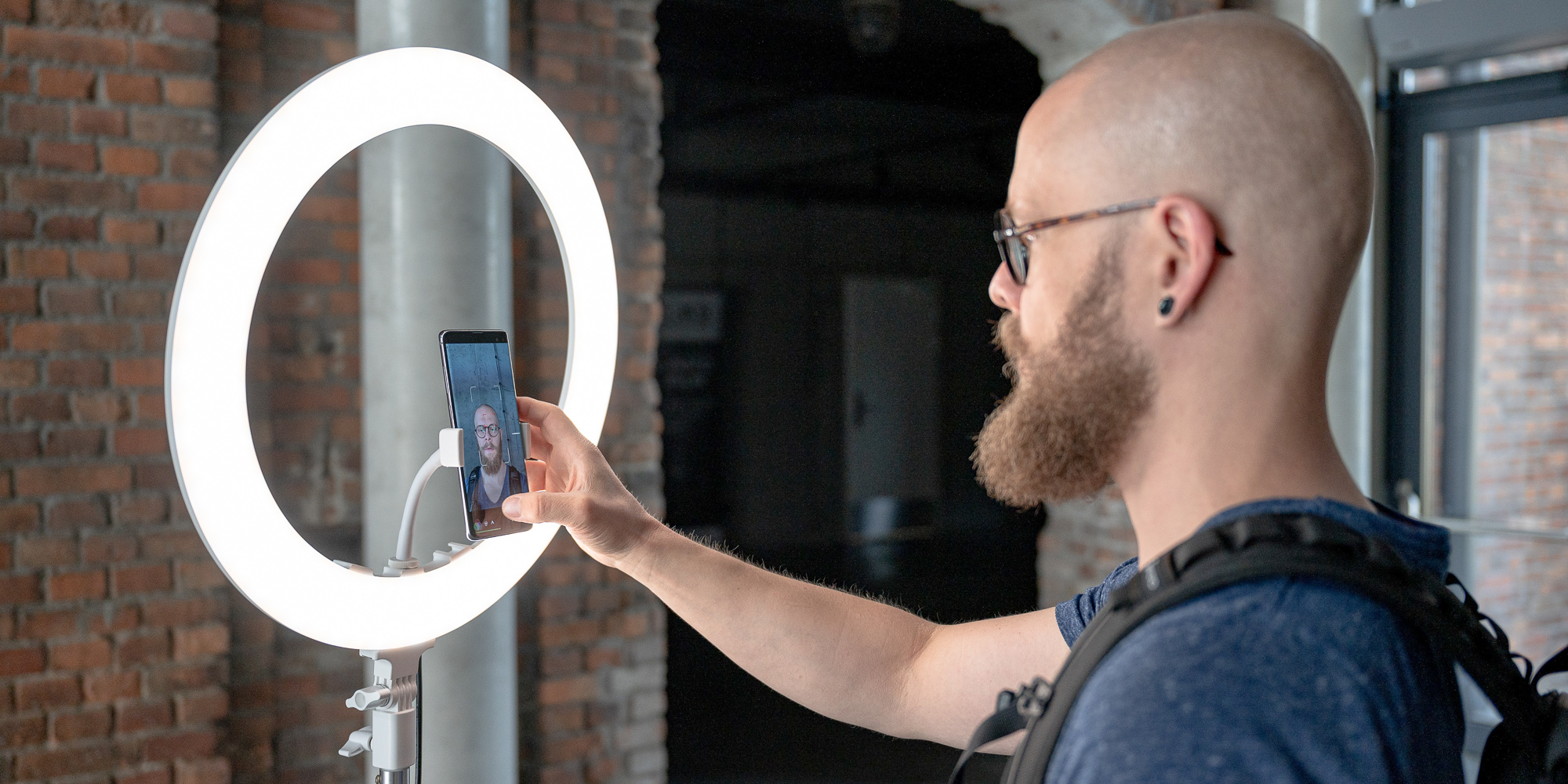
Good light quality is crucial for quality of frames
As you can see, the impact of color temperature and color rendering index (CRI/Ra) on image quality in film and photography is huge. These are key elements that affect the emotion, atmosphere and authenticity of the visual stories we want to tell. Knowledge of these parameters allows filmmakers to achieve better production quality. We hope our guide will help you create better videos and photos.
If you have questions about choosing the right LED lights or selecting the right color temperature, don’t hesitate to contact our technical support department. Our experts will share their knowledge and experience to help you record better vlogs or take even better photos. Remember, creating exceptional visual narratives starts with the right lighting – and we’re on Facebook and Instagram just to help you do that.


